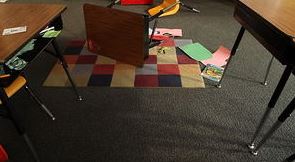The students filed into the cafeteria to hear the candidates’ speeches. In an hour they would be casting their votes for student council president. The two opponents took the stage. The outgoing president gave the instructions:
“You each have two minutes to state your platform. Let us know what makes you an ideal candidate for the job. Afterwards you will each take up to three questions from the audience. Candidate One, your time starts now.”
CANDIDATE 1: “Well, you all know my IQ is one of the highest. Please don’t feel stupid, it’s not your fault. Our student leaders are stupid. I have to say, if I were in charge of the nominations, I’d have looked right into that fat, ugly face of my opponent and said ‘you’re fired’. I mean, would any of you vote for that? Can you imagine that face as our next student council president?”
“Uh, that’s time, Candidate 1. I’m going to stop you right there. Candidate 2, can you please address the student body with what you hope to offer our school with your leadership?”
CANDIDATE 2: “Thank you, Madame President. Before I do that I’d like to address my opponent’s claims. I am really shocked to see such a massive hairdo. Did you all notice it today? It is massive. But I digress. Clearly we have a problem with school resources. I believe we can solve this by requiring all low-income students to wear badges so that we don’t inadvertently give them supplies meant for our gifted program. At least until we can sort all of this budget shortage stuff out.”
Note: No actual high school students were harmed in the creation of this piece. These are, however, direct quotes from some of this year’s presidential hopeful candidates. It is sometimes hard to imagine why candidates would find this kind of bullying to be an effective way of exciting the electorate.
Strong rhetoric, like that currently making up the debates, stimulates the part of our brains that respond to fear and passion, the limbic system. When the limbic system is activated it hijacks the rest of the brain, cutting off access to the cortex and slows our ability to use reason and judgment.
As we come to equate this kind of bullying with strong leadership, we can consider where else in our lives we are likely to substitute passion for the critical thinking skills we know are necessary for learning and growth to occur. Consider the supervisor who ‘sets an example’ by punishing a staff person’s error; the teacher who shames misbehaving students and the relationship that is drama filled and exciting, but lacks deeper intimacy.
In the months since the campaign season began we have seen increased intolerance for diversity and strong divisions along candidate and party lines as people dig in their heels to defend their own ideas. The very concept of dialogue is seen as spineless and weak – candidates who suggest compromise find themselves quickly out of the running.
In our November 23rd posting we discussed the concept of Constructive Differencing, wherein our differences become a tool for expanding our sense of self and of the world. When our leaders encourage us to embrace differences and challenge us towards greater understanding of one another, we become more flexible, agile and able to adapt to change. If we allow fear and aggression to drive our decision making, we may just end up with the leaders, schools and relationships we deserve.





